The Travel & Tourism User Generated Content Market is estimated to be valued at USD 279.8 million in 2025 and is projected to reach USD 1132.1 million by 2035, registering a compound annual growth rate (CAGR) of 15.0% over the forecast period.
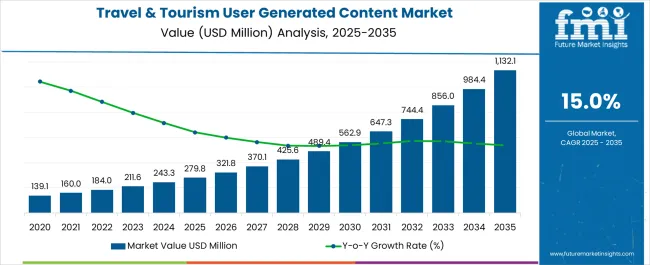
| Metric | Value |
|---|---|
| Travel & Tourism User Generated Content Market Estimated Value in (2025 E) | USD 279.8 million |
| Travel & Tourism User Generated Content Market Forecast Value in (2035 F) | USD 1132.1 million |
| Forecast CAGR (2025 to 2035) | 15.0% |
The travel & tourism user generated content (UGC) market is undergoing strong growth, driven by the convergence of social connectivity, digital storytelling, and trust-based travel discovery. Rising smartphone penetration, faster mobile internet, and the increasing influence of peer content in shaping travel intent are pushing brands to embrace user-generated photos, videos, and reviews as strategic tools.
Consumers are relying more on authentic, first-hand experiences over curated brand messaging, creating a shift toward decentralized and community-driven content ecosystems. Tourism boards and travel platforms are actively investing in partnerships with influencers and encouraging UGC campaigns to amplify destination visibility and drive bookings.
Moving forward, this market is expected to benefit from integration of AI-based content curation tools, gamified sharing models, and immersive media formats such as short-form video and 360° experiences. Additionally, regulatory discussions on digital transparency and ethical data use are influencing how platforms host and leverage travel-focused UGC.
The market is segmented by Platform Type, Type of Content, Booking Channel, Tour Type, and Consumer Orientation and region. By Platform Type, the market is divided into Social media, Blogs, and Video sharing services. In terms of Type of Content, the market is classified into Photos, Videos, Blogs, and Infomercials. Based on Booking Channel, the market is segmented into Online Booking, Phone Booking, and In Person Booking. By Tour Type, the market is divided into Independent Traveller, Package Traveller, and Tour Group. By Consumer Orientation, the market is segmented into Women and Men. Regionally, the market is classified into North America, Latin America, Western Europe, Eastern Europe, Balkan & Baltic Countries, Russia & Belarus, Central Asia, East Asia, South Asia & Pacific, and the Middle East & Africa.
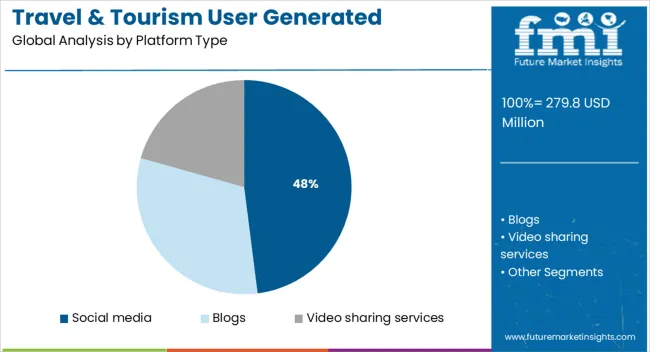
Social media platforms are projected to contribute 48.0% of the total market revenue in 2025, making them the leading platform type for user generated content in travel and tourism. This position is being driven by the platform’s network effect, mobile-first architecture, and visual-rich interface that allows travelers to share real-time moments instantly.
Algorithmic discoverability, story formats, and community engagement tools have enabled continuous circulation of destination-related content, amplifying travel aspirations. Integration of direct booking tools, influencer collaborations, and hashtag-led campaigns has further elevated social media as a primary channel for organic destination promotion.
As brands continue to leverage social listening and sentiment tracking to guide offerings, social platforms remain the most scalable and emotionally resonant medium for UGC engagement.
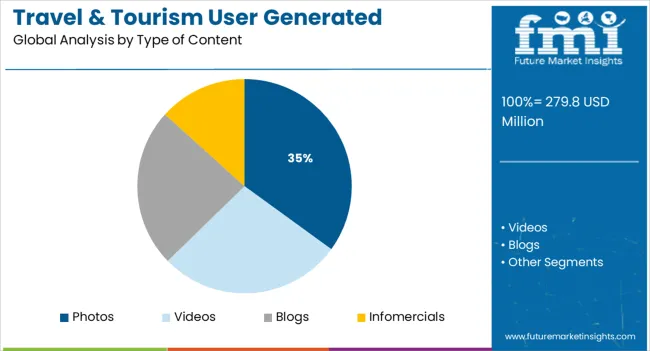
Photo-based content is anticipated to account for 35.0% of the overall market share in 2025, positioning it as the dominant content type. This leadership is being supported by the universal accessibility of photography, ease of sharing, and strong emotional resonance that static visuals carry.
High-quality images of landscapes, accommodations, cuisine, and experiences act as visual testimonials that influence peer perception and travel decisions. With the increasing sophistication of smartphone cameras and editing tools, user participation in travel photography has surged.
Platforms optimized for image sharing, including travel-specific apps and destination microsites, are prioritizing image-first layouts. Photos are also being leveraged in destination marketing, review validation, and itinerary planning, reinforcing their strategic importance across the user journey.
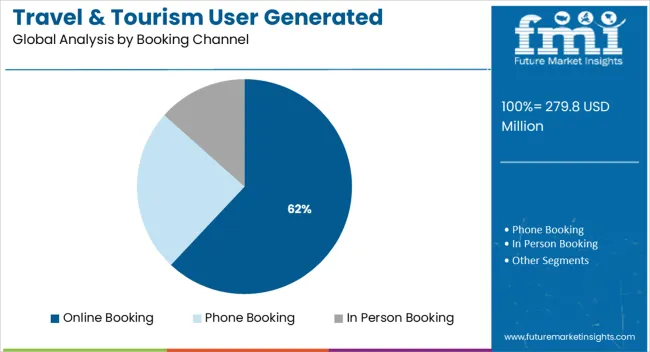
Online booking channels are expected to dominate the market with a 62.0% revenue share in 2025. This segment’s growth is attributed to the convergence of UGC with e-commerce features on travel platforms, allowing for seamless content-to-conversion experiences.
Travelers increasingly trust visual and textual testimonials embedded on booking pages, and platforms are enhancing their algorithms to surface UGC that supports purchasing behavior. Features such as integrated reviews, real traveler photos, and dynamic content feeds contribute to higher booking confidence and reduced bounce rates.
Mobile-first design, one-click payments, and real-time availability integrated with UGC are accelerating transaction volumes. As personalization engines mature, online booking ecosystems are expected to embed deeper UGC touchpoints across every stage of the user journey—from inspiration to post-travel reviews.
User-generated content is sometimes known as citizen media, in contrast to the packaged commodities media of the previous century. Public opinion and news reporting are examples of citizen media. User-generated and user-uploaded audio is a common way that people share their stories. User-generated and user-uploaded video is a common way for people to share their opinions and tell tales.
As user-generated content has grown in popularity, media companies have begun to focus less on producing original web content and more on enabling amateurs. User-generated content is distinctive content created by clients expressly for a company and disseminated via social media or other methods. Pictures, movies, reviews, recommendations, and even podcasts are just a few examples of the many various ways that UGC can be presented.
Due to the COVID-19 outbreak that occurred in the middle of 2020, no travelers were present, making the adverts useless. Restrictions and a general state of lockdown caused a catastrophic market collapse and a sharp decline in the travel market. However, as limitations were relaxed and tourists were preparing to travel once more, the User Generated Content Market experienced a rise in sales in 2024 and 2024. One thing is certain: online research constitutes the first step in travel or vacation planning for 85% of consumers.
They primarily rely on social media and search engines for this (thanks, Google). Typically, travel agents, hotel chains, and price comparison websites only offer the first level of information. Consumers then turn to user-generated material, which is a second level of information that is more reliable, authentic, and seen as trustworthy, to sort through all of these results.
Every element of our life, including the way we consume, has been altered by social media. Businesses have been profoundly impacted by these advances, mostly because they have made new marketing methods possible. Undoubtedly a component of all of these is tourism, one of the most dynamic economic sectors in the world. Social media and tourism marketing combined will produce fantastic benefits for your company. Here, we've included information on the fundamentals of social media in tourism marketing, including what it does and how to utilize it well. Social media's impact on Tourism is seen in the ways people research before they go to their destinations. After, that people share their experiences on social media. Thus social media change the way people think and change their decisions. People built their trust in Travelling agencies based on reviews.
In the travel sector as well, Facebook, Twitter, and Instagram have been at the forefront. Travel is one of the most popular themes on all of these channels, despite the fact that each has its distinct audience.
Facebook is a great tool for attracting users from many social groupings. Using Facebook's recommendations tool, users can share their personal stories. It can be utilized successfully for travel-related objectives to learn what users are saying about your travel agency. Instagram is among the most successful social media platforms. For tourism-related enterprises, it is a fantastic platform for connecting with both present and potential clients. Since millennials are a demographic that uses Instagram heavily, using it will help you draw new customers. To increase the reach of your posts, you should use both famous travel hashtags and your own. Twitter is your voice, whereas Instagram dominates your visual content. Twitter can be utilized for brand-related images and videos, but its true strength lies in its ability to be very helpful for customer service.
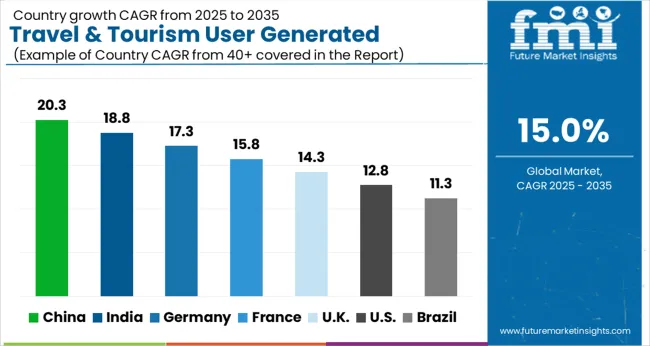
Its primary objective now is to expand and promote the Greek tourism industry through the implementation of marketing tourism initiatives both domestically and internationally, employing its wide network of international offices. Moreover, the GNTO has been and continues to be essential in the national effort to promote Greece, this truly exceptional and amazing destination, both cost-effectively and efficiently. This is due to its extensive experience, expertise, and a large network of associates and stakeholders both in Greece and abroad. It belongs to the ETC and the UNWTO. The organization has contributed to a number of effective advertising projects, notably the highly effective Live your myth in Greece campaign. You in Greece was the campaign's tagline for 2010. In addition to the brief videos sent to social media accounts and YouTube channels. Campaigns are also advertised on TV and with posters highlighting the country's cultural and natural landmarks. Localities and the organization make YouTube videos together to advertise Greek Tourism.
The Incredible India 2.0 Campaign, launched by the Ministry of Tourism, represents a change from global generic promotions to market-specific promotional programs and content creation. The Campaign takes into mind both growing markets with high potential and the key source markets for Indian tourism. The campaign focuses on increasing digital presence through portals with broad audiences, niche genres, social media, and television as a medium because of the wide audience it can reach. As part of the campaign, thematic television ads and creatives have been created. Print, television, online, and social media campaigns on a global scale in significant and potential source markets abroad. Print, TV, radio, outdoor, and other domestic campaigns and advertisement on social media creation of publicity materials and creatives.
South Africa provides both domestic and foreign visitors with a wide range of possibilities, including beautiful natural scenery and wildlife reserves, varied cultural history, and well-known wines. Several national parks, including the sizable Kruger National Park in the north of the country, the coastlines and beaches of the provinces of KwaZulu-Natal and Western Cape, and large towns like Cape Town, Johannesburg, and Durban are some of the most well-liked locations. The overall framework for tourism development is still the National Tourism Sector Strategy, which was amended in 2020 and adopted in 2020. It is a 10-year strategy that runs until 2029. Effective marketing, destination management, facilitating easy access, visitor experience, and broad-based benefits make up its main foundations.
Social Media are the most preferred Platform type in the Travel & Tourism User Generated Content Market
The enormously popular social media sites like Facebook, Instagram, YouTube, and Twitter each offer content that may be used in inventive ways and reflect distinct aspects of your community. There's no need to restrict your content nurturing to a small number of social platforms because User Generated Content can be transformed into useful experiences on your website, emails, advertising, and even in-store. However, understanding which social platforms produce the best content for your brand and understanding how to use that content is essential to seamlessly giving your customers the best experience.
Online booking channels lead the booking channel segmentation
The majority of booking channels have switched over to accepting bookings online as a result of the widespread availability of the internet and the online presence of leading businesses in the market. The ease with which one can use online channels and the abundance of tour possibilities available through these platforms are both credited with this rise. In this scenario, the factors that matter most are likewise a hassle-free experience and the comfort of reserving at your convenience. The most popular and significant market share is anticipated to continue to be held by the online booking channel.
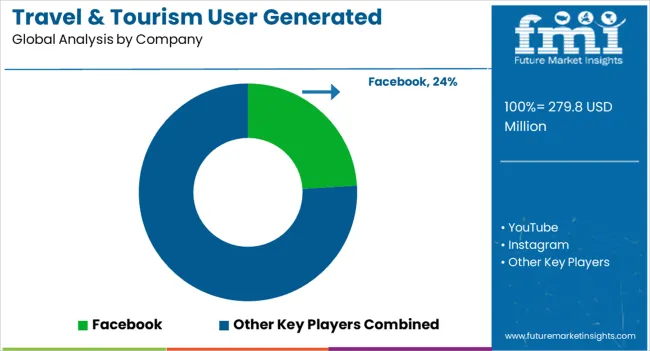
The key players are maintaining a competitive edge in the market by offering all-inclusive packages and saving tourists from the hassle of going through different channels for their tours. Most tourists are not well prepared and are looking for advice on how to organize a trip. Therefore, making websites easy to use and engaging will assist draw in visitors and make it simpler to sell vacation packages. The travel and tourism firm provides a fantastic interactive ad for promoting more sales by using such concepts and planning to design the websites, content, photographs, and videos on display, branding, etc. Government initiatives and investments are boosting the market and have also helped the firms improve their service offerings.
For Instance:
| Attribute | Details |
|---|---|
| Forecast Period | 2025 to 2035 |
| Historical Data Available for | 2020 to 2024 |
| Market Analysis | USD Million for Value |
| Key Regions Covered | Europe; North America; Latin America; Europe; East Asia; South Asia; Oceania & the Middle East; and Africa(MEA). |
| Key Countries Covered | USA, Canada, Brazil, Mexico, Germany, United Kingdom, France, Spain, Italy, Russia, Benelux, South Africa, Northern Africa, GCC Countries, China, Japan, South Korea, India, Thailand, Malaysia, Indonesia, Australia & New Zealand, Greece, South Africa. |
| Key Segments Covered | Platform Type, Type of content, Booking Channel, Tourist Type, Tour Type, Consumer Orientation, Age Group, and Region |
| Key Companies Profiled | Travel Technology & Solutions; Amara Marketing and among others |
| Report Coverage | Market Forecast, Company Share Analysis, Competition Intelligence, Drivers, Restraints, Opportunities and Threats Analysis, Market Dynamics and Challenges, and Strategic Growth Initiatives |
| Customization & Pricing | Available upon Request |
The global travel & tourism user generated content market is estimated to be valued at USD 279.8 million in 2025.
The market size for the travel & tourism user generated content market is projected to reach USD 1,132.1 million by 2035.
The travel & tourism user generated content market is expected to grow at a 15.0% CAGR between 2025 and 2035.
The key product types in travel & tourism user generated content market are social media, blogs and video sharing services.
In terms of type of content, photos segment to command 35.0% share in the travel & tourism user generated content market in 2025.






Full Research Suite comprises of:
Market outlook & trends analysis
Interviews & case studies
Strategic recommendations
Vendor profiles & capabilities analysis
5-year forecasts
8 regions and 60+ country-level data splits
Market segment data splits
12 months of continuous data updates
DELIVERED AS:
PDF EXCEL ONLINE
Travel Advertising Market Size and Share Forecast Outlook 2025 to 2035
Travel Pouches Market Size and Share Forecast Outlook 2025 to 2035
Travel Trailer Market Size and Share Forecast Outlook 2025 to 2035
Travel Bags Market Size and Share Forecast Outlook 2025 to 2035
Travel Vaccines Market Size and Share Forecast Outlook 2025 to 2035
Travel Accessories Market Analysis by Product Type, Material, Distribution Channel, End-User and Region 2025 to 2035
Travel Expenses Processing Market Analysis By Type, By End User, By Booking Channel, By Region Forecast: 2025 to 2035
Travel SIM MVNO Market by MVNO Type, Coverage, End User & Region Forecast till 2035
Understanding Market Share Trends in Travelers Identity Protection
Travelers Identity Protection Services Market Analysis by Service Type, by Subscription Model, by End User , by Nationality and by Region - Forecast for 2025 to 2035
Travel Intermediaries Business Market Analysis - Growth & Forecast 2025 to 2035
Travelport GDS Systems Market Trends - Growth & Forecast 2025 to 2035
Travel Agency Services Market Analysis by Services Provided, by Tourist Type, by Tour Type, by Demography, by Age Group and by Region– Forecast for 2025-2035
Market Share Distribution Among Travel Agency Services Providers
Travel Management Software Market
Travel Toiletry Market Report – Demand & Industry Growth 2024-2034
Travel and Expense Management Software Market
UK Travel Agency Services Market Report – Trends, Demand & Outlook 2025-2035
B2B Travel Market Size and Share Forecast Outlook 2025 to 2035
USA Travel Agency Services Market Analysis – Size, Share & Forecast 2025-2035

Thank you!
You will receive an email from our Business Development Manager. Please be sure to check your SPAM/JUNK folder too.
Chat With
MaRIA